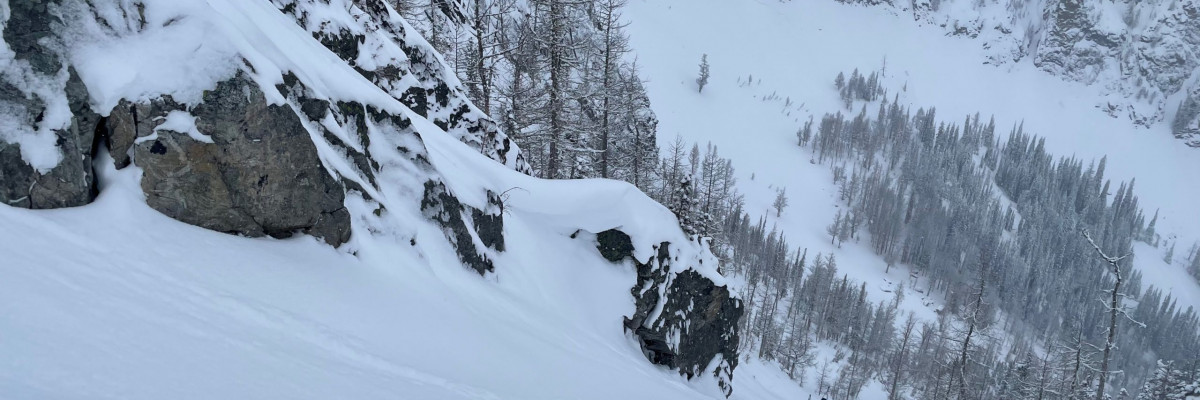The avalanche danger in the west central Montana backcountry is Moderate. Heightened avalanche conditions exist on specific terrain features. Evaluate snow and terrain carefully.
Good Morning. This is Jeff Carty with the West Central Montana Avalanche Center advisory on Thursday, February 18, 2021. This advisory is sponsored by LB Snow. This advisory does not apply to operating ski areas and expires at midnight tonight. The USDA Forest Service is solely responsible for its content.
Snowpack and Weather
Mountain temperatures range from 8º to 16º and will rise up to 30º today. Between 0.2″ and 1.4″ SWE has fallen, depending on location, in the past 48 hrs. Winds have been moderate and westerly with strong gusts and will be light out of the southwest today. The next round of snow arrives this evening.
Variability continues to be the theme throughout the forecast area with avalanche conditions differing broadly by aspect and elevation. As a result, careful terrain and snowpack assessment are essential for safe travel.
Overall conditions are improving, with many areas showing good bonding at problem layers. Exceptions to this are areas of:
- Wind slab
- Persistent weak layers
- New snow instabilities
Persistent weak layers continue to be an issue in many zones. Previously shallow snowpacks at mid-elevations and wind swept areas have multiple faceted layers deep in the snowpack that are failing in stability tests and collapsing during travel. It is possible to trigger large destructive avalanches in these areas from above, below, and adjacent to slopes. North aspects were scoured by north winds last week and rapidly faceted by the frigid cold. Very weak snow underlies the new snow. As this consolidates, larger avalanches will become more likely. Frequent snowpack investigation is required to determine the presence of facets. Snow pits, probing with ski poles, and quick hand pits will all aid assessment. Where facets are found, avoid slopes over 30º.
Winds were loading leeward slopes in the Rattlesnake and central Bitterroot yesterday. Wind slabs were cracking and sliding in some places. Avoid wind-loaded start zones over 35º in upper elevations.
New snow was sluffing easily and quickly in steep terrain yesterday. While small, these sluffs could knock a skier off their feet. Terrain traps increase the consequences of these slides. In many areas, the new snow is denser than the underlying snow and as it consolidates soft storm slab avalanches are possible, convexities close to 38º are the most likely places for these.
The Bottom Line
Heightened avalanche conditions exist on specific terrain features. It is possible to trigger an avalanche on persistent weak layers, windslab, storm slab, and in loose snow today.
Mid elevations and north aspects are the most likely places to find persistent weak layers. Wind slabs are found at upper elevations over 35º. Loose snow and storm slab is an issue on slopes over 38º. Frequent terrain and snowpack assessment are essential for safe travel.
Carry a beacon, shovel, and probe. Reassess conditions throughout the day and stay alert for signs of instability. Dig pits. Look for red flags.
Upcoming Education Events
Please visit our education page for an up-to-date list of regional educational events and course offerings. Below are a few select events and opportunities to check out.
- February 24th, 6-7:30 PM MST | FREE Online 1.5-hr Avalanche Awareness Session | Missoulaavalanche.org event | Delivered by A3 Pro instructors | Get more details and register HERE
Special Announcements
You’ve prayed, hoped, and danced for snow all winter, and it’s finally here! Western Montana’s mountains are busier than ever before, with new and veteran backcountry users enjoying the new snow. The West Central Montana Avalanche Foundation wants to ensure everyone has the information needed to enjoy the mountains and return home safely. To celebrate the return of winter and support west-central Montana’s avalanche forecasting and education programs, we bring you Loving La Niña! This virtual fundraising event includes two outstanding gear packages and two ways to enter to win. Please click HERE for more information about this exciting event. Together, we can save lives and continue creating the most fun, safe, and responsible backcountry community possible. Spread the word, and spread the love for La Niña!
Public Observations
Thank you to everyone who has taken the time to send in a public observation. Please keep sharing what you find and see while out in the backcountry. This online forum is a great resource to glean information about current conditions.
You can now text us your observations to (406) 219-5566 when you don’t have time to fill out the observations page. Texted observations won’t get posted on the website, but will be used in the development of the forecast.
Ski and ride safe.
























